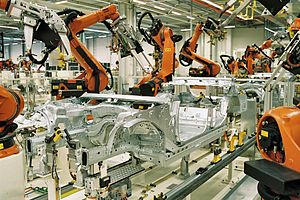
High technology (high tech), also known as advanced technology (advanced tech) or exotechnology, [1][ failed verification] is technology that is at the cutting edge: the highest form of technology available. [2] It can be defined as either the most complex or the newest technology on the market. [3] The opposite of high tech is low technology, referring to simple, often traditional or mechanical technology; for example, a slide rule is a low-tech calculating device. [4] [5] [6] When high tech becomes old, it becomes low tech, for example vacuum tube electronics. Further, high tech is related to the concept of mid-tech, that is a balance between the two opposite extreme qualities of low-tech and high-tech. Mid-tech could be understood as an inclusive middle that combines the efficiency and versatility of digital/automated technology with low-tech's potential for autonomy and resilience. [7]
Startups working on high technologies (or developing new high technologies) are sometimes referred to as deep tech; the term may also refer to disruptive innovations or those based on scientific discoveries. [8]
High-tech, as opposed to high-touch, may refer to self-service experiences that do not require human interaction. [9]
History
The phrase was used in a 1958 The New York Times story advocating " atomic energy" for Europe: "... Western Europe, with its dense population and its high technology ...." [10] Robert Metz used the term in a financial column in 1969, saying Arthur H. Collins of Collins Radio "controls a score of high technology patents in a variety of fields" [11] and in a 1971 article used the abbreviated form, "high tech". [12]
A widely used classification of high-technological manufacturing industries was provided by the OECD in 2006. [13] It is based on the intensity of research and development activities used in these industries within OECD countries, resulting in four distinct categories. [14]
List of countries by high tech exports
The following is a list of the 15 largest exporting countries of high tech products by value in thousands of United States dollars, according to the World Bank: [15]
| # | Country | Value | Year |
|---|---|---|---|
| 1 | 942,314,815.52 | 2021 | |
| 2 | 431,628,771.88 | 2021 | |
| 3 | 209,744,317.15 | 2021 | |
| 4 | 169,217,253.98 | 2021 | |
| 5 | 163,987,147.75 | 2020 | |
| 6 | 159,927,958.42 | 2020 | |
| 7 | 116,513,861.43 | 2021 | |
| 8 | 108,683,179.4 | 2021 | |
| 9 | 101,534,392.93 | 2020 | |
| 10 | 101,168,437.61 | 2021 | |
| 11 | 97,528,027.44 | 2021 | |
| 12 | 74,932,493.34 | 2021 | |
| 13 | 66,699,915.64 | 2021 | |
| 14 | 52,227,761.21 | 2021 | |
| 15 | 45,837,990.48 | 2020 |
See also
- Electronics
- Electronics industry
- Photonics industry
- Nuclear technology
- Quantum technology
- Intermediate technology – sometimes used to mean technology between low and high technology
- Industrial design
- List of emerging technologies
- Semiconductor industry
- Big Tech
- Innovation
References
- ^ Advanced technology definition
- ^ Cortright, Joseph; Mayer, Heike (January 2001). High Tech Specialization: A Comparison of High Technology Centers (PDF). Brookings Institution, Center on Urban & Metropolitan Policy.
- ^ Steenhuis, H.; Bruijn, E. J. De (July 2006). "High technology revisited: Definition and position". 2006 IEEE International Conference on Management of Innovation and Technology (PDF). Vol. 2. pp. 1080–1084. doi: 10.1109/ICMIT.2006.262389. ISBN 1-4244-0147-X. S2CID 32767300.
- ^ "Know How To Use a Slide Rule? - Slashdot". science.slashdot.org. 28 September 2007. Retrieved 2019-11-04.
- ^ "Slide Rules Were the Original Personal Computers". 5 November 2015.
- ^ Slide Rules & Calculators https://www.tnmoc.org/slide-rules-calculators
- ^ Kostakis, Vasilis; Pazaitis, Alex; Liarokapis, Minas (2023-06-20). "Beyond high-tech versus low-tech: A tentative framework for sustainable urban data governance". BigData&Society. 10 (1). doi: 10.1177/20539517231180583. ISSN 2053-9517.
- ^ "What is Deep Tech and which startups are marking the road (not Uber)". Startup Business (in Italian). 2018-04-20. Retrieved 2020-10-13.
- ^ Williams, Howard (6 June 2019). "Do Customers Want High Tech or High Touch?". Home Business Magazine. Retrieved 2020-03-22.
- ^ "Atomic Power for Europe", The New York Times, February 4, 1958, p. 17.
- ^ Metz, Robert (1969). "Market Place: Collins Versus The Middle Man", The New York Times, April 24, 1969, p. 64.
- ^ Metz, Robert (1971). "Market Place: So What Made E.D.S. Plunge?", The New York Times, November 11, 1971, p. 72.
- ^ Hatzichronoglou, Thomas: "Revision of the High-Technology Sector and Product Classification", OECD Science, Technology and Industry Working Papers, No. 1997/02, OECD Publishing, Paris.
- ^ High Tech Trademarks by John Mendenhall, Art Direction Book Co; First Edition (January 1, 1985) ISBN 0881080241
- ^ "High-technology exports". World Bank Open Data. Retrieved 2023-04-15.